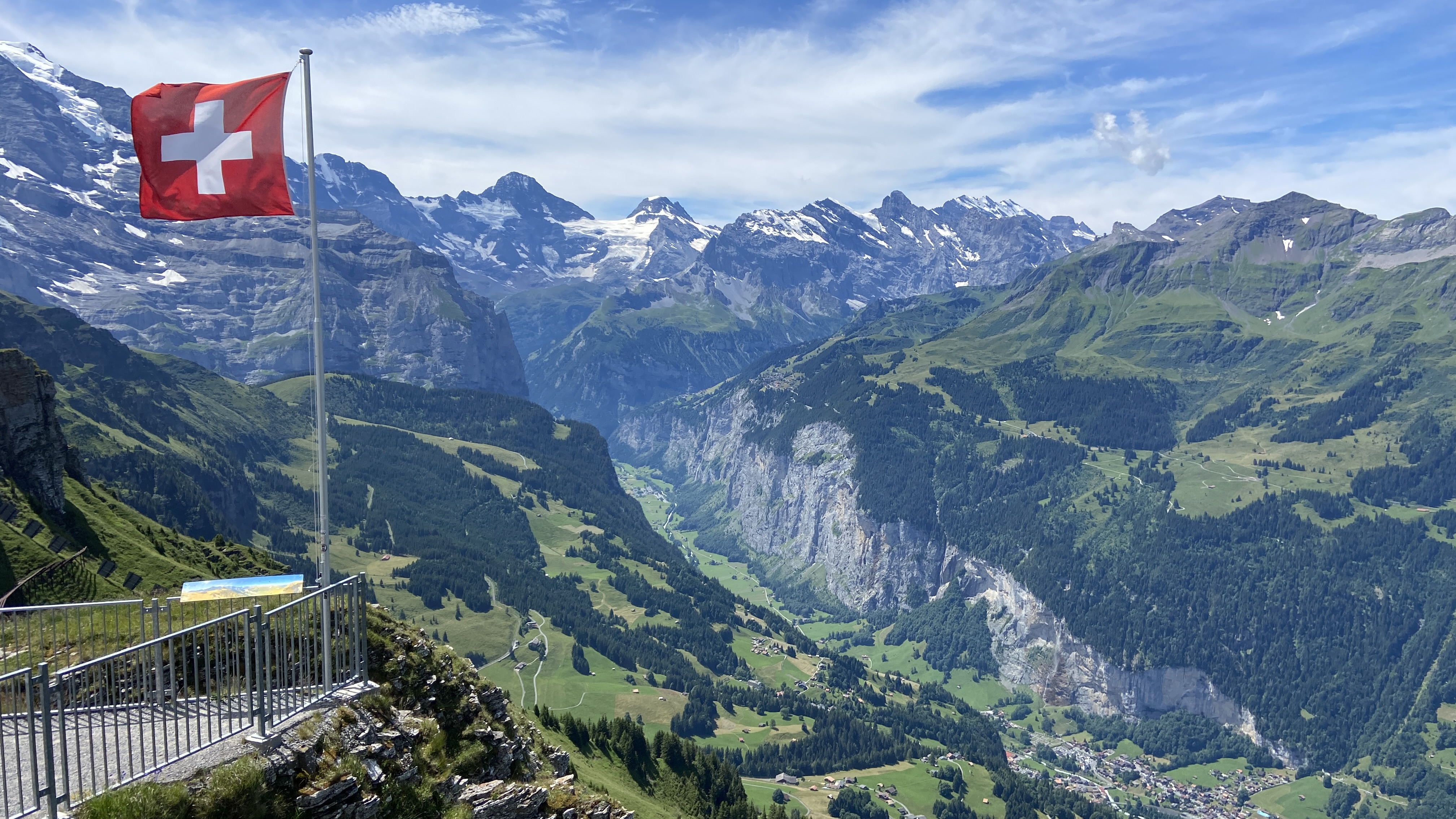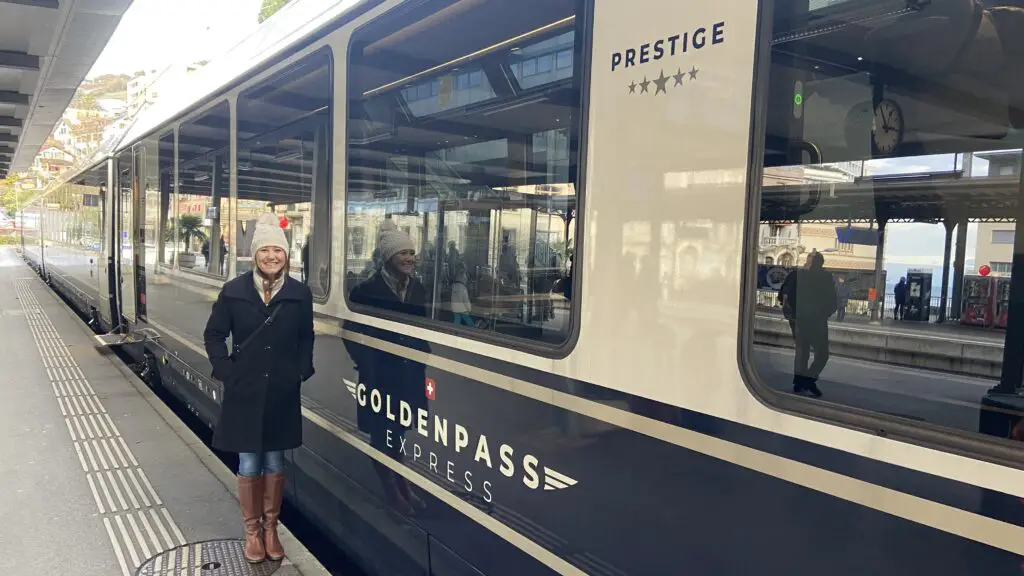Using a Eurail Pass in Switzerland…is it a GOOD idea or a BAD idea? Guess you’ll have to keep reading to find out!
But before we get too carried away sharing opinions, let’s make sure we’re on the same page — what exactly is a Eurail Pass?
Want to Watch instead of Read?
What you need to know about the Eurail Pass
The Eurail Pass is — you guessed it! — a rail pass designed for travel throughout Europe.
- There’s a Eurail Global Pass that’s valid for travel throughout 33 different European countries, including Switzerland.
- And there are 1 Country Passes made for travel within a single country, but unfortunately there isn’t a 1-Country option for Switzerland.
- The Eurail Global Pass is available year-round, and there are options for quite a few different lengths of time. The continuous passes are available for 15 days, 22 days, 1 month, 2 months, or 3 months in a row. The Flexi Passes allow you to travel for 4, 5, or 7 days of your choice within a 1-month period, or 10 or 15 days within a 2-month period.
- Eurail Passes are available for First Class or Second Class travel, and a unique perk of these passes is the discounted pricing for a few age groups:
- Youth under the age of 27 get 25% off the standard adult prices.
- Seniors over the age of 60 get 10% off.
- And kids under the age of 11 can travel for free, with a limit of 2 children per adult. (Though it’s very important to mention that this is only the case on routes 100% covered by the Eurail Pass, and there are often much better options for kids to travel for free or very cheap within Switzerland!)
Now, everything we’ve just said about the Eurail Global Pass is also true of the Interrail Global Pass — so what’s the difference?
- Well, the Eurail Pass is only available to non-European residents, and the Interrail Pass is only for European residents.
- But they’re effectively the same pass. So for the rest of this blog, even though we’ll just be referring to the “Eurail Pass,” know that these thoughts apply to both the Eurail Global Pass and the Interrail Global Pass.
General Overview of the Eurail Pass in Switzerland
Before I explain how the Eurail Pass works in Switzerland, let me introduce myself.
I’m Brett, and my wife, Jana, and I live near Interlaken. Our business — Aplins in the Alps — exists to help you travel Switzerland with confidence. And one of my particular areas of expertise is hardcore nerding out on all things Swiss transportation.
But I’m not just here to give you my personal opinions — I let the numbers speak for themselves. I’ve run literally hundreds of sample trip itineraries through my super nerdy spreadsheet to calculate the raw data.
And then I use that information to help you pick the best transportation pass for your trip to Switzerland. We talk about more Swiss train passes in our other blogs, but today we’re just gonna keep focusing on the Eurail Pass.

So here’s how it works in Switzerland in general:
- Trains between cities and towns throughout Switzerland are 100% covered by the Eurail Pass…but that’s where the simplicity ends!
- Boats are mostly 50% discounted, although some are 100% covered and some are not discounted at all.
- Mountain trains and cable cars usually come at a 25% discount, but sometimes have a 50% discount and other times you’ll have to pay full price.
- And buses aren’t covered by the Eurail Pass at all.
Eurail Pass for Trips to Switzerland ONLY
Which brings me to the first important question: if Switzerland is the ONLY destination you’ll be visiting in Europe, is buying a Eurail Pass for your trip a GOOD idea or a BAD idea?
The answer is pretty simple: it’s a BAD IDEA!
And that’s because I want you to think about the Eurail Pass as a European rail pass and not specifically as a Swiss train pass. It’s best for trips covering significant distances throughout multiple European countries, and it’s always a BAD IDEA to buy a Eurail Pass if you’re only going to Switzerland!
Well, actually there is one rare exception that’s PERFECT for using a Eurail Pass even if you’re just visiting Switzerland (I told you I’m nerdy about numbers!), but I’ll mention that in a moment.
So, if you’re only coming to Switzerland, I give you permission to stop reading this blog and switch to this one instead, where we help you understand the different Swiss train passes and dish out our free Swiss Train Pass Checklist to pick the best pass for your specific itinerary. (But of course stick around if you want the rest of the juicy secrets!)
Eurail Pass for Trips Throughout Europe
If you’re still with me, I’m glad you’re here! So, if you’re already planning to buy a Eurail Pass for other countries in Europe, there are two big questions you might still have:
- Should you buy extra days so your Eurail Pass pass will cover your trip to Switzerland in addition to your other European adventures?
- If you have unused days leftover on your Eurail Pass, is it a good idea to use them in Switzerland?
Now, my level of nerditude is only focused on Switzerland, so I’m not equipped to tell you if it’s a GOOD IDEA or BAD IDEA to buy a Eurail Pass for trips to Italy, France, or anywhere else in Europe. But I can definitely answer those two questions for you starting with some of the popular regions in Switzerland.

The Eurail Pass in The Jungfrau Region
First up is the Jungfrau Region. For starters, the Eurail Pass 100% covers:
- Train travel to Interlaken, Grindelwald, and Lauterbrunnen
- Travel from Lauterbrunnen up to Wengen and Mürren
- And boat rides on Lake Brienz and Lake Thun
The Eurail Pass gives a 50% discount on rides to:
But there’s only a 25% discount on:
- The train from Grindelwald to Kleine Scheidegg to Wengen
- The Eiger Express
- The train to Jungfraujoch
- The cable cars to Männlichen
- The entire Schilthorn cable car line
- And the funicular to Allmendhubel
And there’s no discount for:
- Bus rides throughout the region
- The cable car to Pfingstegg
- The steam train to the Brienzer Rothorn
- Or the trip up to Oeschinensee
To answer question #1: Should you buy extra days so your Eurail Pass pass will cover your trip to the Jungfrau Region in addition to your other European adventures?
- If you’ll have a 4-, 5-, or 7-day Eurail Pass and are planning to spend up to 3 days in the Jungfrau Region, it’s a GOOD IDEA to add on extra days. The numbers just make sense. But I’ll be honest — we live in the Jungfrau Region and it’s one of the best places to visit in Switzerland, so you’re gonna want more than 3 days here!
- And for those trips of longer than 3 days, it’s a BAD IDEA to buy extra days just so you can use your Eurail Pass here. For example, if you follow our 1-Week Guide to the Jungfrau Region, you’d spend over 400 CHF on the costs of tickets alone with the Eurail Pass. Now, that’s 50 CHF cheaper than if you had purchased a Swiss Half Fare Card and used it to buy half price tickets, but then you still have to factor in the cost of adding more days to your Eurail Pass. And because of that extra cost, it quickly becomes a BAD IDEA.
By the way, I’m curious, how many of you are buying a Eurail Pass for trips less than 1 week?
In fact, would you leave us a comment if you’re planning to buy a Eurail Pass and tell us how many days it’s for and where you’ll be traveling?
Hearing about the types of trips you’re planning helps us cater our content to provide you with the most useful tips and recommendations — and it gives me more sample itineraries to add to my geeky spreadsheet!
To answer question #2: Let’s say you’re taking that big Euro-trip, and you’ll have unused days on your Eurail Pass once you arrive in Switzerland. Is it a good idea to use your “free days” in the Jungfrau Region?
- Of course, if your plans only include the routes that are 100% covered, then this is a GOOD IDEA!
- And even if you choose to visit all 3 locations that are just 50% covered by your Eurail Pass, it’s still a GOOD IDEA.
- But when you start taking lots of the rides that are only 25% off or not discounted at all — or the free days leftover on your pass only cover part of your time in Switzerland — this is where it gets dicey and I call it a BAD IDEA. If you’re not careful, you could end up spending more with the Eurail Pass than if you had just bought another pass in the first place.
So in summary, I think that using free days on a Eurail Pass while you’re traveling in the Jungfrau Region is generally a GOOD IDEA.

The Eurail Pass in Zermatt
Now let’s head toward the Italian border to look at how the Eurail Pass performs in Zermatt — and this one’s pretty simple.
The Eurail Pass 100% covers train travel to Zermatt.
But once you’re in Zermatt, there are no discounts. That’s right — you’ll have to pay full price to visit Gornergrat and Matterhorn Glacier Paradise, and to ride on the Sunnegga-Rothorn line, even if you have a valid Eurail Pass.
Does it ever make sense to use a Eurail Pass here? Nope, BAD IDEA! You should never add extra days to a Eurail Pass just to cover your time in Zermatt, and you should never use free days you’ll have leftover — because you’d be paying full price anyway!
So should you just pay full price for all of your transportation in Zermatt? Just a quick reminder that all of our Swiss Travel Guides contain detailed recommendations of which train pass or train pass combination to buy, as well as how much you can expect to spend in transportation costs if you follow our itineraries.

The Eurail Pass in Lucerne and Central Switzerland
So what about a visit to Lucerne and Central Switzerland?
The Eurail Pass 100% covers:
- Train travel to Lucerne
- And throughout the region
But it only gives a 50% discount to:
- Mt. Pilatus
- Mt. Rigi
- Boat rides on Lake Lucerne
And the Eurail Pass offers 25% off on rides to:
But there’s no discount, for example, for bus rides throughout the region or to reach the Stoos Ridge Hike.
Question #1 | Should you buy extra days so your Eurail Pass pass will cover your trip to Central Switzerland in addition to your other European adventures?
- Once again, it’s a GOOD IDEA if you already plan to have a 4-7 day Eurail Pass and just want to add 1-2 days for your travels near Lucerne.
- Beyond that, it’s a BAD IDEA because you’ll spend more money adding additional days to your Eurail Pass than you would by paying full price for tickets or buying a different train pass.
Question #2 | And if you’ll have unused days on your Eurail Pass, is it a good idea to use them near Lucerne?
- Of course it’s a GOOD IDEA if all you’ll do is travel throughout the region by train on routes that are covered 100%.
- And if you want to enjoy a few mountain excursions or boat rides, it’s probably still a GOOD IDEA for a few days, but be sure to price this out compared to simply buying another train pass.

The Eurail Pass for City-to-City Trips and Swiss Panoramic Trains
Remember earlier when I said that using the Eurail Pass for a trip just to Switzerland is a bad idea, with just one exception? Well, here it is.
If you’re coming to Switzerland and plan to hop around from one city to another, covering lots of ground, or concentrating your train travel to a handful of high-volume travel days, then the Eurail Pass is probably a GOOD IDEA.
And if you’re planning to focus your trip on multiple Swiss panoramic trains or travel into or out of Switzerland from another country, then it’s likely also a GOOD IDEA.
For example, the Eurail Pass 100% covers:
- All train travel between cities
- And popular scenic trains, like the Glacier Express, GoldenPass Express, Bernina Express, and the Luzern-Interlaken Express. Although I do need to point out that the Eurail Pass covers your tickets on these panoramic trains, but you will need to book and pay for your seat reservations separately.
But check this out: let’s look at a sample itinerary where you spend 4 days riding some of the more expensive city-to-city and scenic train routes.
- Day 1: Zurich Airport to Interlaken (77 CHF full price)
- Day 2: Interlaken to Zermatt (86 CHF full price)
- Day 3: Glacier Express panoramic train (159 CHF full price)
- Day 4: Bernina Express panoramic train (107 CHF full price)
If you paid full price for just these 4 rides alone, you’d spend 429 CHF.
But a 4-Day Eurail Global Flexi Pass costs just 265 CHF, and the price would be even better if you qualify for senior or youth discounts.
Now you’re probably thinking, “Why wouldn’t I just buy the Swiss Travel Pass? Wouldn’t that be even better?”
Well, a 4-Day Swiss Travel Pass Flex for adults costs 339 CHF. And the Eurail Pass is actually cheaper than a Swiss Travel Pass in every case, until you get to the 15-day pass length.
And a little bonus for our European viewers — there is actually a 1-country Interrail Pass just for Switzerland. It’s available as a Flexi pass for 3, 4, 5, 6, or 8 days within a 1-month period, and using this sample itinerary, it beats both the Eurail Global Pass and Swiss Travel Pass by a landslide!
In fact, a 3-day Interrail Switzerland Pass is cheaper than the cost of 1 full-price ticket on the Glacier Express. So if you’re a European resident, this could be a very, very GOOD IDEA!
Man, I love being a nerd! 🙂
Now it’s important to mention that this would be a very unique trip and I just picked it to make an example. It’s definitely not an itinerary I would recommend because there’s just too much amazing stuff to see in Switzerland to fly through the country like that!
And while the Eurail and Interrail Passes are cheaper than the Swiss Travel Pass, they will quickly become a BAD IDEA if you want to ride more than a few routes that aren’t 100% covered, since even discounted ticket prices can quickly add up.
But to be honest, I think the better comparison is to see how the Eurail Pass holds up against other options like the Swiss Half Fare Card and some of the popular regional train passes.
Other Swiss Train Passes
And speaking of those other options, that’s exactly why we created our Ultimate Guide to Swiss Train Passes, which includes a step-by-step checklist to ensure you end up with your ideal balance of cost savings and convenience for wherever your itinerary takes you in Switzerland. So be sure to check that out next and we’ll see you in Switzerland!


